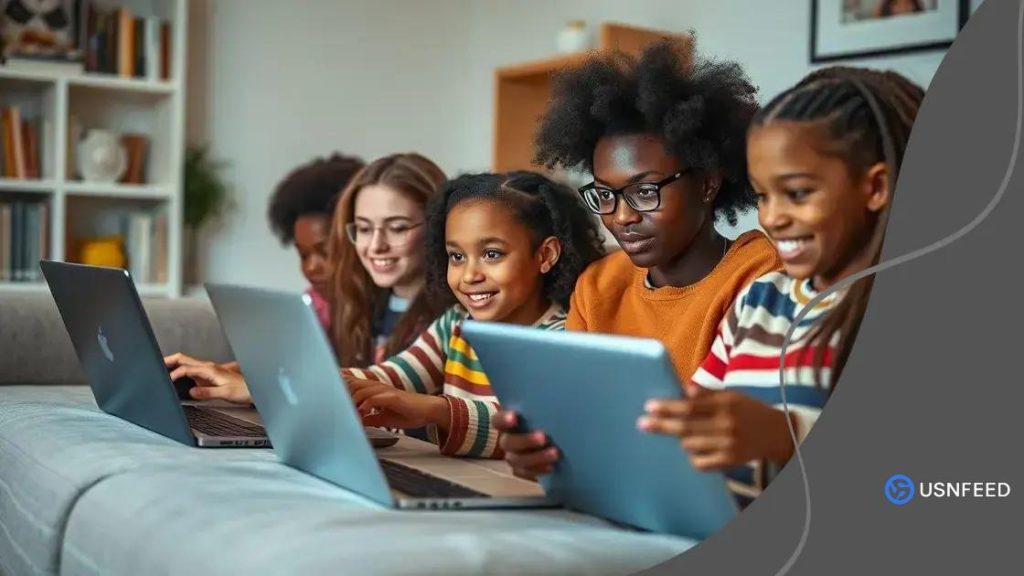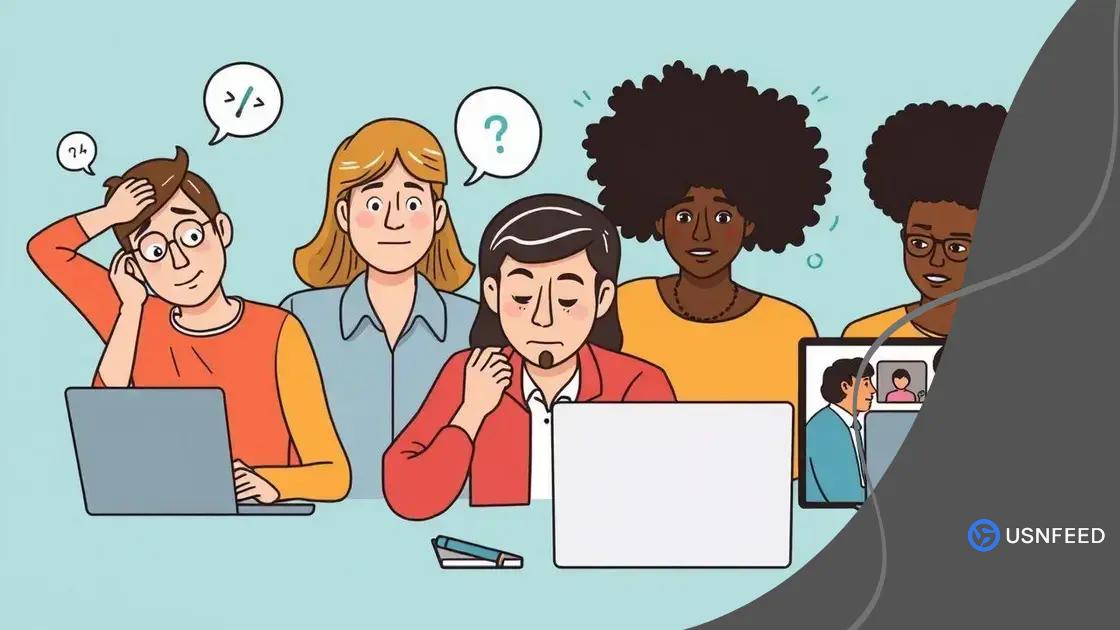The future of online learning in America is now

The future of online learning will be shaped by advancements in artificial intelligence, virtual reality, and personalized education, enhancing accessibility and engagement for students.
The future of online learning in America is more exciting than ever, with technology transforming how we experience education. Have you considered how this shift might impact your learning journey?
Trends shaping online learning
As technology continues to evolve, trends shaping online learning are transforming education in exciting ways. From the rise of interactive platforms to personalized learning approaches, these trends are guiding the future of education.
Adaptive Learning Technologies
One significant trend is the use of adaptive learning technologies. These tools adjust content based on individual performance, helping learners grasp concepts more effectively. By offering tailored lessons, they enhance the learning experience and ensure that students remain engaged.
Gamification of Education
Gamification is another innovative approach gaining traction. This method incorporates game design elements into lessons, making learning fun and interactive. Students are motivated to explore new concepts through points, levels, and challenges, which makes their educational journey enjoyable.
Mobile Learning
With the proliferation of smartphones and tablets, mobile learning is essential. Students can access educational materials anytime, anywhere, allowing for flexibility in their studies. This accessibility supports various learning styles and accommodates busy schedules.
Moreover, social learning platforms are rising in popularity. These platforms allow students to connect and collaborate, fostering a sense of community. Interaction with peers not only supports learning but also builds valuable social skills.
Microlearning
Microlearning has become a preferred method, offering small, bite-sized lessons. This approach focuses on delivering concise information that students can easily digest, making it ideal for busy learners. By breaking down complex topics, it helps reinforce knowledge retention.
The future of online learning will be shaped by these trends. By embracing new technologies and methods, the education system can better serve students’ needs and prepare them for success in an ever-changing world.
Benefits of remote education
Remote education offers numerous benefits that enhance the learning experience. Many students find it allows for greater flexibility and personal convenience, which can lead to better engagement.
Flexibility in Learning
One of the key advantages of remote education is the flexibility it provides. Students can learn at their own pace, choosing when and where to study. This self-directed learning approach empowers them to balance their education with personal commitments.
Access to Resources
Remote education opens up access to a wealth of resources. Online platforms provide a variety of materials, including videos, articles, and interactive simulations. These resources cater to different learning styles, making education more inclusive and effective.
Cost-Effectiveness
Moreover, opting for remote education can be cost-effective. Students save on transportation and housing costs, and many online courses are more affordable than traditional classes. This enables wider access to quality education without the burden of debt.
Social interaction is another noteworthy aspect. Although remote, students can engage with peers through discussion boards and group projects. This interaction fosters teamwork and communication skills, essential for their future careers. Many schools also use live sessions to create a more interactive environment, allowing immediate feedback and support.
Personalized Learning Experiences
Personalization in learning experiences is a major benefit of remote education. Through assessments and predictive analytics, educators can tailor instruction to meet individual needs. This targeted approach helps students achieve their academic goals more effectively.
Overall, the benefits of remote education are significant. Students can enjoy personalized learning, flexible schedules, and rich resource access while saving costs, which ultimately contributes to a more efficient and enjoyable educational journey.
Challenges faced by online learners

Online learners face a variety of challenges that can impact their educational experience. Understanding these hurdles is essential for creating better support systems.
Time Management Issues
One significant challenge is managing time effectively. Without a structured environment, students may struggle with procrastination or become overwhelmed by their workload. This can lead to stress and decreased performance. To address this, learners can create schedules and set specific goals.
Limited Interaction
Another challenge is the limited interaction with instructors and peers. In a traditional classroom, face-to-face communication fosters relationships and immediate feedback. Online learners may feel isolated and miss out on networking opportunities.
Technical Difficulties
Technical issues can also hinder online learning. Problems like slow internet connections or software glitches can disrupt classes and leave students frustrated. Ensuring that students have access to reliable technology is crucial for their success.
Moreover, maintaining motivation can be challenging in an online setting. The absence of a classroom environment may lead some students to lose focus on their studies. Finding ways to stay engaged, like joining study groups or participating in discussions, can combat this issue.
Adjusting to Different Learning Styles
Adapting to diverse learning styles can be difficult for online learners. Some may struggle with self-directed learning if they prefer structured guidance. Recognizing different styles and incorporating various resources can help accommodate all students.
By acknowledging these challenges, educational institutions can work to create better online learning experiences. Providing resources, technical support, and community-building opportunities can aid in overcoming these obstacles.
The role of technology in education
Technology plays a vital role in modern education, transforming how students learn and interact with information. It creates new opportunities and methods that enhance the educational experience.
Improved Accessibility
One of the key benefits of technology in education is improved accessibility. Online resources allow students to access information from anywhere at any time. This is particularly beneficial for students with disabilities, who may require specific tools to aid their learning.
Interactive Learning Environments
Technology has enabled the creation of interactive learning environments. Tools like virtual labs, simulations, and collaborative software encourage engagement and participation. Students are more likely to absorb information when they can interact with the material.
Personalized Learning Experiences
Another significant aspect is personalized learning experiences. With intelligent learning systems, educational content can be tailored to the individual needs of each student. This customization helps students learn at their own pace and ensures they grasp concepts effectively.
Moreover, technology in education allows for the incorporation of diverse multimedia resources. Videos, podcasts, and educational games can make learning enjoyable while catering to various learning styles. This variety keeps students engaged and motivated to continue exploring new subjects.
Data-Driven Insights
Additionally, technology provides valuable data-driven insights for educators. By analyzing student performance, teachers can identify areas where students struggle and adapt their teaching strategies accordingly. This feedback loop fosters continuous improvement in the learning process.
The role of technology in education continues to grow as new innovations emerge. It transforms traditional classrooms into dynamic learning hubs, equipping students with the skills they need to thrive in a digital world.
Future predictions for online learning
Future predictions for online learning suggest a dynamic shift in education that could change how we view formal education entirely. As technology continues to advance, various trends are emerging that promise to enhance learning experiences.
Increased Integration of Artificial Intelligence
One major prediction is the increased integration of artificial intelligence (AI) in online education. AI can personalize learning experiences and provide tailored feedback to students. This technology will help identify students’ strengths and weaknesses, allowing educators to adjust their teaching methods accordingly.
Expansion of Virtual Reality (VR) and Augmented Reality (AR)
Another exciting advancement is the expansion of virtual reality (VR) and augmented reality (AR) in classrooms. These technologies can create immersive learning experiences that allow students to explore complex topics in a realistic environment. For example, students might take virtual field trips that bring lessons to life.
Rise of Microcredentialing
The rise of microcredentialing is also on the horizon. Students will be able to earn microcredentials for specific skills, making education more flexible and relevant to job markets. This approach allows learners to showcase their achievements in a more granular way, which is attractive to employers.
Additionally, continuing education will likely become more common. As industries evolve, professionals will seek ongoing training to stay current. Online platforms will offer courses that cater specifically to these needs, making education more accessible and adaptable.
Blended Learning Models
Lastly, blended learning models are predicted to gain traction. These models combine online and face-to-face instruction, providing the best of both worlds. Students can benefit from the flexibility of online learning while still receiving personal interaction with instructors.
The future of online learning will likely be an exciting blend of technology and human interaction, making education more inclusive and effective. As these trends develop, students will have access to more resources and opportunities than ever before.
FAQ – Frequently Asked Questions about the Future of Online Learning
What role will artificial intelligence play in online education?
Artificial intelligence will personalize learning experiences and provide tailored feedback to enhance student engagement.
How will virtual and augmented reality be used in education?
VR and AR will create immersive learning environments, allowing students to explore complex subjects in realistic ways.
What is microcredentialing and why is it important?
Microcredentialing allows students to earn credentials for specific skills, making education more relevant and flexible for job markets.
What are blended learning models?
Blended learning combines online and in-person instruction, providing a flexible learning environment that combines the best of both worlds.